You have a chatbot that was built by using the Microsoft Bot Framework.
You need to debug the chatbot endpoint remotely.
Which two tools should you install on a local computer? Each correct answer presents part of the solution.
NOTE: Each correct selection is worth one point.
Answer:
CE
Bot Framework Emulator is a desktop application that allows bot developers to test and debug bots, either locally or remotely. ngrok is a cross-platform application that "allows you to expose a web server running on your local machine to the internet." Essentially, what we'll be doing is using ngrok to forward messages from external channels on the web directly to our local machine to allow debugging, as opposed to the standard messaging endpoint configured in the Azure portal.
Reference:
https://docs.microsoft.com/en-us/azure/bot-service/bot-service-debug-emulator
DRAG DROP -
You are building a retail chatbot that will use a QnA Maker service.
You upload an internal support document to train the model. The document contains the following question: "What is your warranty period?"
Users report that the chatbot returns the default QnA Maker answer when they ask the following question: "How long is the warranty coverage?"
The chatbot returns the correct answer when the users ask the following question: 'What is your warranty period?"
Both questions should return the same answer.
You need to increase the accuracy of the chatbot responses.
Which three actions should you perform in sequence? To answer, move the appropriate actions from the list of actions to the answer area and arrange them in the correct order.
Select and Place: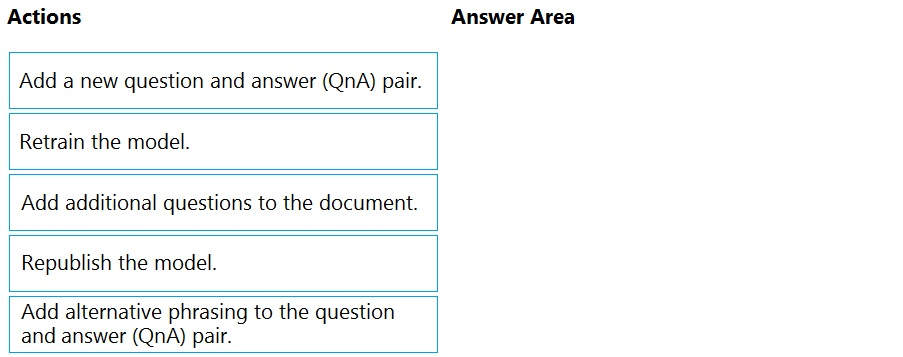
Answer:
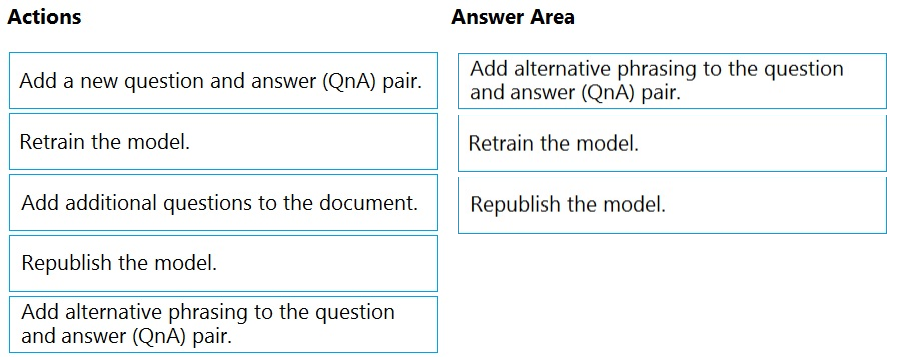
Step 1: Add alternative phrasing to the question and answer (QnA) pair.
Add alternate questions to an existing QnA pair to improve the likelihood of a match to a user query.
Step 2: Retrain the model.
Periodically select Save and train after making edits to avoid losing changes.
Step 3: Republish the model -
Note: A knowledge base consists of question and answer (QnA) pairs. Each pair has one answer and a pair contains all the information associated with that answer.
Reference:
https://docs.microsoft.com/en-us/azure/cognitive-services/qnamaker/how-to/edit-knowledge-base
You need to measure the public perception of your brand on social media by using natural language processing.
Which Azure service should you use?
Answer:
A
Text Analytics Cognitive Service could be used to quickly determine the public perception for a specific topic, event or brand.
Example: A NodeJS app which pulls Tweets from Twitter using the Twitter API based on a specified search term. Then pass these onto Text Analytics for sentiment scoring before storing the data and building a visualisation in PowerBI. The Architecture looked something like this: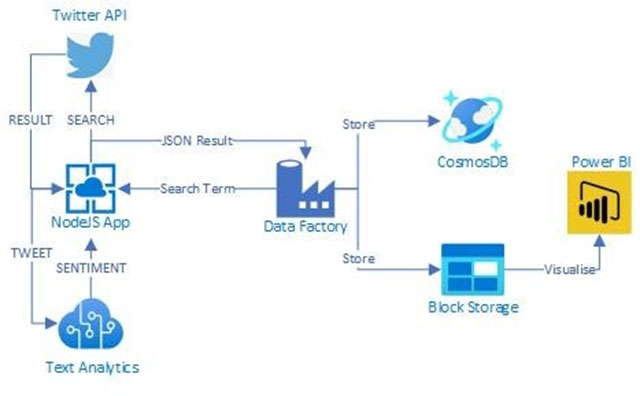
Reference:
https://www.linkedin.com/pulse/measuring-public-perception-azure-cognitive-services-steve-dalai https://docs.microsoft.com/en-us/azure/cognitive-services/text-analytics/overview
Note: This question is part of a series of questions that present the same scenario. Each question in the series contains a unique solution that might meet the stated goals. Some question sets might have more than one correct solution, while others might not have a correct solution.
After you answer a question in this section, you will NOT be able to return to it. As a result, these questions will not appear in the review screen.
You build a language model by using a Language Understanding service. The language model is used to search for information on a contact list by using an intent named FindContact.
A conversational expert provides you with the following list of phrases to use for training.
✑ Find contacts in London.
✑ Who do I know in Seattle?
✑ Search for contacts in Ukraine.
You need to implement the phrase list in Language Understanding.
Solution: You create a new intent for location.
Does this meet the goal?
Answer:
A
An intent represents a task or action the user wants to perform. It is a purpose or goal expressed in a user's utterance.
Define a set of intents that corresponds to actions users want to take in your application.
Reference:
https://docs.microsoft.com/en-us/azure/cognitive-services/luis/luis-concept-intent
Note: This question is part of a series of questions that present the same scenario. Each question in the series contains a unique solution that might meet the stated goals. Some question sets might have more than one correct solution, while others might not have a correct solution.
After you answer a question in this section, you will NOT be able to return to it. As a result, these questions will not appear in the review screen.
You build a language model by using a Language Understanding service. The language model is used to search for information on a contact list by using an intent named FindContact.
A conversational expert provides you with the following list of phrases to use for training.
✑ Find contacts in London.
✑ Who do I know in Seattle?
Search for contacts in Ukraine.
You need to implement the phrase list in Language Understanding.
Solution: You create a new entity for the domain.
Does this meet the goal?
Answer:
B
Instead use a new intent for location.
Note: An intent represents a task or action the user wants to perform. It is a purpose or goal expressed in a user's utterance.
Define a set of intents that corresponds to actions users want to take in your application.
Reference:
https://docs.microsoft.com/en-us/azure/cognitive-services/luis/luis-concept-intent
You are training a Language Understanding model for a user support system.
You create the first intent named GetContactDetails and add 200 examples.
You need to decrease the likelihood of a false positive.
What should you do?
Answer:
A
Active learning is a technique of machine learning in which the machine learned model is used to identify informative new examples to label. In LUIS, active learning refers to adding utterances from the endpoint traffic whose current predictions are unclear to improve your model.
Reference:
https://docs.microsoft.com/en-us/azure/cognitive-services/luis/luis-glossary
DRAG DROP -
You are building a Language Understanding model for purchasing tickets.
You have the following utterance for an intent named PurchaseAndSendTickets.
Purchase [2 audit business] tickets to [Paris] [next Monday] and send tickets to [[email protected]]
You need to select the entity types. The solution must use built-in entity types to minimize training data whenever possible.
Which entity type should you use for each label? To answer, drag the appropriate entity types to the correct labels. Each entity type may be used once, more than once, or not at all.
You may need to drag the split bar between panes or scroll to view content.
Select and Place: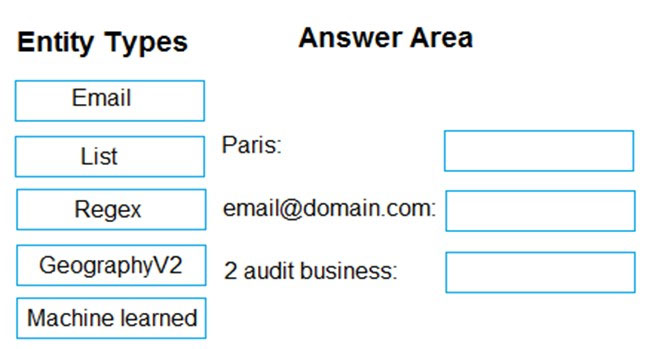
Answer:
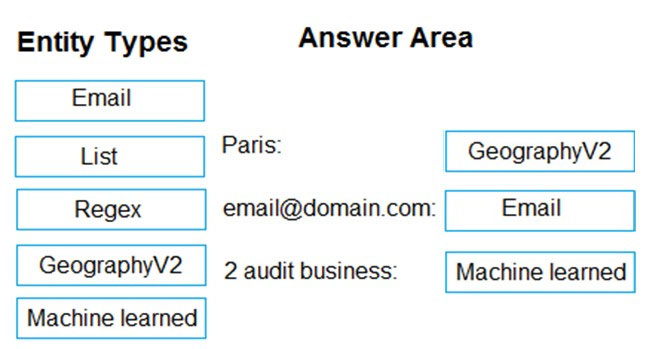
Box 1: GeographyV2 -
The prebuilt geographyV2 entity detects places. Because this entity is already trained, you do not need to add example utterances containing GeographyV2 to the application intents.
Box 2: Email -
Email prebuilt entity for a LUIS app: Email extraction includes the entire email address from an utterance. Because this entity is already trained, you do not need to add example utterances containing email to the application intents.
Box 3: Machine learned -
The machine-learning entity is the preferred entity for building LUIS applications.
Reference:
https://docs.microsoft.com/en-us/azure/cognitive-services/luis/luis-reference-prebuilt-geographyv2 https://docs.microsoft.com/en-us/azure/cognitive-services/luis/luis-reference-prebuilt-email https://docs.microsoft.com/en-us/azure/cognitive-services/luis/reference-entity-machine-learned-entity
You have the following C# method.
You need to deploy an Azure resource to the East US Azure region. The resource will be used to perform sentiment analysis.
How should you call the method?
Answer:
B
To perform sentiment analysis, we specify TextAnalytics, not ContentModerator.
Possible SKU names include: 'F0','F1','S0','S1','S2','S3','S4','S5','S6','S7','S8'
Possible location names include: westus, eastus
Reference:
https://docs.microsoft.com/en-us/powershell/module/az.cognitiveservices/new-azcognitiveservicesaccount
You build a Conversational Language Understanding model by using the Language Services portal.
You export the model as a JSON file as shown in the following sample.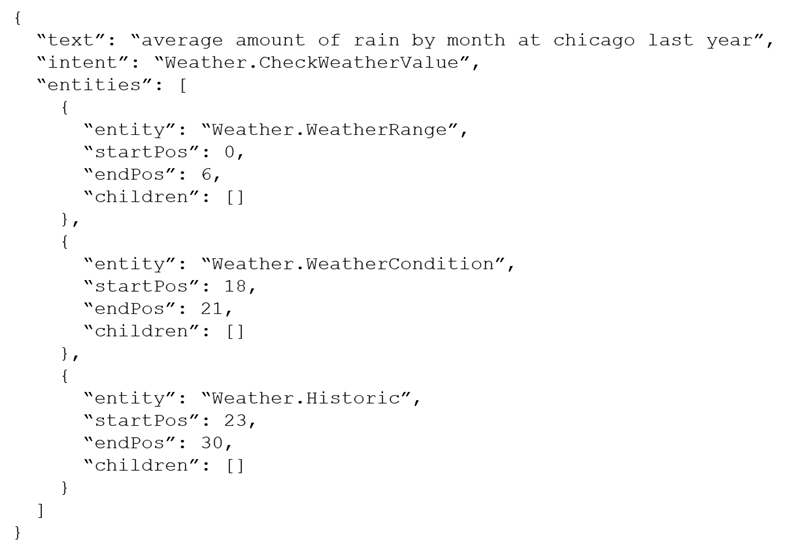
To what does the Weather.Historic entity correspond in the utterance?
Answer:
A
You are examining the Text Analytics output of an application.
The text analyzed is: `Our tour guide took us up the Space Needle during our trip to Seattle last week.`
The response contains the data shown in the following table.
Which Text Analytics API is used to analyze the text?
Answer:
B
Named Entity Recognition (NER) is one of the features offered by Azure Cognitive Service for Language, a collection of machine learning and AI algorithms in the cloud for developing intelligent applications that involve written language. The NER feature can identify and categorize entities in unstructured text. For example: people, places, organizations, and quantities.
Reference:
https://docs.microsoft.com/en-us/azure/cognitive-services/language-service/named-entity-recognition/overview